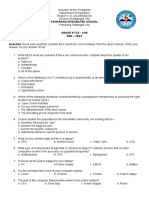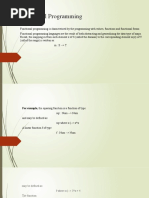0 ratings0% found this document useful (0 votes)
330 viewsCSS NC II - Diagnostic
The document provides definitions for 20 common computer-related terms, including hardware components like the system unit, motherboard, and computer mouse. It also defines software terms such as operating system, computer virus, anti-virus, and computer software. Key computer networks and technologies are explained, such as WIFI, the Internet, and the Android operating system.
Uploaded by
CherryFlorBolanioGenitaCopyright
© © All Rights Reserved
Available Formats
Download as DOCX, PDF, TXT or read online on Scribd
0 ratings0% found this document useful (0 votes)
330 viewsCSS NC II - Diagnostic
The document provides definitions for 20 common computer-related terms, including hardware components like the system unit, motherboard, and computer mouse. It also defines software terms such as operating system, computer virus, anti-virus, and computer software. Key computer networks and technologies are explained, such as WIFI, the Internet, and the Android operating system.
Uploaded by
CherryFlorBolanioGenitaCopyright
© © All Rights Reserved
Available Formats
Download as DOCX, PDF, TXT or read online on Scribd
You are on page 1/ 2
CSS NC II – Pre Diagnostic Test
Name: __________________________________________ Date: ____________________
1. an electronic device for storing and processing data, typically in binary form, according
to instructions given to it in a variable program. - computer
2. a piece of computer equipment on which information can be stored. – Storage Device
3. an input device that allows a person to enter letters, numbers, and other symbols –
Computer Keyboard
4. a hand-held pointing device that detects two-dimensional motion relative to a surface.
This motion is typically translated into the motion of a pointer on a display, which allows
a smooth control of the graphical user interface. – Computer Mouse
5. A device that converts analog audio signals into the equivalent air vibrations in order to
make audible sound. When CRT monitors were the norm, speakers designed
for computers were shielded to avoid magnetic interference with the CRT's magnetic
coil. Getting Smaller All the Time. – Computer Speaker
6. a common interface that enables communication between devices and a host controller
such as a personal computer (PC). It connects peripheral devices such as digital
cameras, mice, keyboards, printers, scanners, media devices, external hard drives and
flash drives. – USB
7. also known as a "tower" or "chassis," is the main part of a desktop computer. It includes
the motherboard, CPU, RAM, and other components. ... The term "system unit" is often
used to differentiate between the computer and peripheral devices, such as the monitor,
keyboard, and mouse. – System Unit
8. a small electronic device containing flash memory that is used for storing data or
transferring it to or from a computer, digital camera, etc. – Flash Drive
9. converts mains AC to low-voltage regulated DC power for the internal components of
acomputer. – Computer Power Supply
10. a printed circuit board containing the principal components of a computer or other
device, with connectors into which other circuit boards can be slotted. – Mother Board
11. the software that supports a computer's basic functions, such as scheduling tasks,
executing applications, and controlling peripherals. – Operating Sytem
12. is a set of instructions and its associated documentations that tells a computer what to
do or how to perform a task.Software includes all different software programs on
a computer, such as applications and the operating system. – Computer Software
13. he physical, tangible parts or components of a computer, such as the cabinet, central
processing unit, monitor, keyboard, computer data storage, graphics card, sound
card, speakers and motherboard. – Computer Hardware
14. a piece of code which is capable of copying itself and typically has a detrimental effect,
such as corrupting the system or destroying data. – Computer Virus
15. a computer program used to prevent, detect, and remove malware. – Anti Virus
16. a computer that is portable and suitable for use while traveling. – Laptop
17. an open-source operating system used for smartphones and tablet computers. – Android
18. a facility allowing computers, smartphones, or other devices to connect to the Internet or
communicate with one another wirelessly within a particular area. – WIFI
19. a global computer network providing a variety of information and communication
facilities, consisting of interconnected networks using standardized communication
protocols. – Internet
20. an output device that displays information in pictorial form. – Computer Monitor
You might also like
- Foreign Exchange Options and Risk Management - Market Dynamics, Models and Human BehaviourNo ratings yetForeign Exchange Options and Risk Management - Market Dynamics, Models and Human Behaviour408 pages
- LO 3. Create New Business Ideas in Computer Systems Servicing by Using Various Techniques100% (1)LO 3. Create New Business Ideas in Computer Systems Servicing by Using Various Techniques14 pages
- Summative Test 3-Assembly and DiassemblyNo ratings yetSummative Test 3-Assembly and Diassembly1 page
- SDO Navotas TLE10 CSS Q3 M6 Installing-Configuring-Computer-Systems FVNo ratings yetSDO Navotas TLE10 CSS Q3 M6 Installing-Configuring-Computer-Systems FV10 pages
- 12ICT-CSS - 05 ORIENTATION and Network Design PresentationNo ratings yet12ICT-CSS - 05 ORIENTATION and Network Design Presentation16 pages
- Quarter 3 - Module 1-W4&W5: Answer & Submit This Page. (W4-1)No ratings yetQuarter 3 - Module 1-W4&W5: Answer & Submit This Page. (W4-1)11 pages
- Quarter 3 - Module 1-W3: Computer Systems Servicing (CSS)No ratings yetQuarter 3 - Module 1-W3: Computer Systems Servicing (CSS)3 pages
- Lesson Plan in Ict/ Computer Systems Servicing-10: I. ObjectiveNo ratings yetLesson Plan in Ict/ Computer Systems Servicing-10: I. Objective4 pages
- Tle Daily Lesson Log: A. Content StandardNo ratings yetTle Daily Lesson Log: A. Content Standard2 pages
- A. Preliminary Activity:: Integration With English LiteracyNo ratings yetA. Preliminary Activity:: Integration With English Literacy6 pages
- Louiglen - P CSS-3rd-Periodical-Exam-Test-Paper100% (1)Louiglen - P CSS-3rd-Periodical-Exam-Test-Paper3 pages
- Sessions: Session 1 Session 2 Session 3 Session 4: I. ObjectivesNo ratings yetSessions: Session 1 Session 2 Session 3 Session 4: I. Objectives3 pages
- Lesson Plan - December 1-31, 2017 - FinalNo ratings yetLesson Plan - December 1-31, 2017 - Final3 pages
- Department of Education: Detailed Lesson PlanNo ratings yetDepartment of Education: Detailed Lesson Plan4 pages
- Las Css 9 2nd Quarter - Padapada National HsNo ratings yetLas Css 9 2nd Quarter - Padapada National Hs3 pages
- CSS Grade 11 TLE - IACSS9-12PCO-Ie-f-6 June 19100% (1)CSS Grade 11 TLE - IACSS9-12PCO-Ie-f-6 June 196 pages
- LESSON 2 - Assembling A Computer - Performance ChecklistNo ratings yetLESSON 2 - Assembling A Computer - Performance Checklist2 pages
- Lesson 2 PLAN AND PREPARE FOR INSTALLATIONNo ratings yetLesson 2 PLAN AND PREPARE FOR INSTALLATION44 pages
- Install Softwae Application Summative AssesmentNo ratings yetInstall Softwae Application Summative Assesment3 pages
- Third Quarter - Lesson 1: Plan and Prepare Maintenance Procedures100% (1)Third Quarter - Lesson 1: Plan and Prepare Maintenance Procedures9 pages
- Ict - chs9 Lesson 1 - Basic Computer Configuration SetupNo ratings yetIct - chs9 Lesson 1 - Basic Computer Configuration Setup29 pages
- Daily Lesson Log in Tle I.Objectives: Lesson 3. Inspect and Test The Configured Computer Systems and NetworksNo ratings yetDaily Lesson Log in Tle I.Objectives: Lesson 3. Inspect and Test The Configured Computer Systems and Networks61 pages
- Paharang Integrated School: Department of EducationNo ratings yetPaharang Integrated School: Department of Education6 pages
- Technology Livelihood Education: (ICT) Computer System Servicing (CSS)100% (1)Technology Livelihood Education: (ICT) Computer System Servicing (CSS)31 pages
- Unsupervised Learning of Video Representations Using LstmsNo ratings yetUnsupervised Learning of Video Representations Using Lstms12 pages
- Lecture On Database by Miss Aysha (GCUF)No ratings yetLecture On Database by Miss Aysha (GCUF)6 pages
- The Design of A Garment Requires InnovationNo ratings yetThe Design of A Garment Requires Innovation4 pages
- 9MA0 01 9MA0 02 A Level Pure Mathematics Practice Set 13No ratings yet9MA0 01 9MA0 02 A Level Pure Mathematics Practice Set 135 pages
- Review of "An Economic Analysis of A Drug-Selling Gang's Finances" by Steven D. Levitt and Sudhir Alladi VenkateshNo ratings yetReview of "An Economic Analysis of A Drug-Selling Gang's Finances" by Steven D. Levitt and Sudhir Alladi Venkatesh2 pages
- Mto Structure and Foundation CondensateNo ratings yetMto Structure and Foundation Condensate39 pages
- Critical Success Factors in Projects PinNo ratings yetCritical Success Factors in Projects Pin20 pages
- Lexber Inc. V Sps. Dalman G.R. No. 183587, April 20, 2015No ratings yetLexber Inc. V Sps. Dalman G.R. No. 183587, April 20, 201514 pages
- Coherence in The Quran and A Brief Analysis of Sura Al BaqarahNo ratings yetCoherence in The Quran and A Brief Analysis of Sura Al Baqarah52 pages
- En Collection of Data Sheets MPS PA 090804No ratings yetEn Collection of Data Sheets MPS PA 090804194 pages

























































































